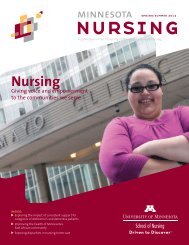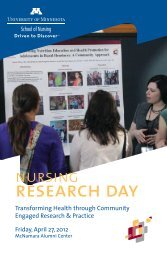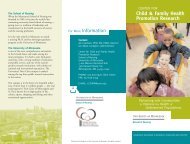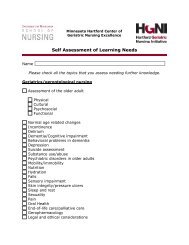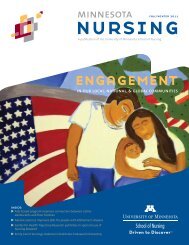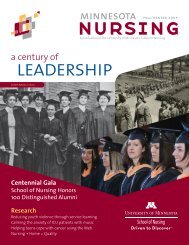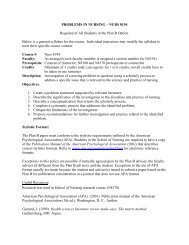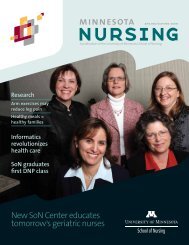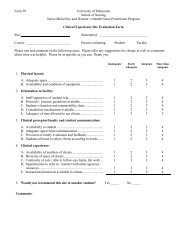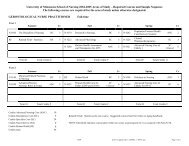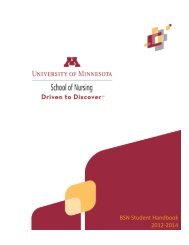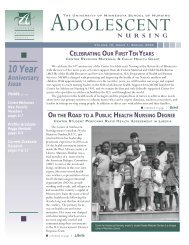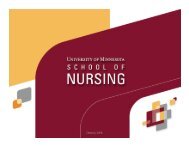Fall/Winter 2002 - School of Nursing - University of Minnesota
Fall/Winter 2002 - School of Nursing - University of Minnesota
Fall/Winter 2002 - School of Nursing - University of Minnesota
You also want an ePaper? Increase the reach of your titles
YUMPU automatically turns print PDFs into web optimized ePapers that Google loves.
Across the country, schools <strong>of</strong> nursing have reported a<br />
large number <strong>of</strong> applicants with degrees in other fields and<br />
have developed “fast tracks” to the M.S. degree to accommodate<br />
them. Currently, B.S.N. students who enter with<br />
a degree in another field take at least six years to become<br />
nurses: four years in the non-nursing field and two years<br />
in the nursing major. If you consider the need for most <strong>of</strong><br />
these students to complete pre-requisite science courses<br />
prior to admission to nursing, it is more likely to take<br />
seven years.<br />
At the <strong>School</strong> <strong>of</strong> <strong>Nursing</strong>, we are excited and encouraged<br />
by the strong interest expressed in this program. Even<br />
before it was approved by the Regents, the <strong>School</strong> <strong>of</strong> <strong>Nursing</strong><br />
database registered over 700 inquiries about the Post<br />
Baccalaureate Certificate Program. Attendance at information<br />
sessions has been impressive. We admitted 24<br />
students to the inaugural class and hope to increase the<br />
number <strong>of</strong> students to 32 in coming years. In addition to<br />
several biology and psychology/child psychology majors,<br />
those admitted have undergraduate degrees in fields as varied<br />
as sociology, history, accounting, journalism, and<br />
business administration. The average age <strong>of</strong> the 24<br />
students is 27 year old.<br />
We would like to thank Marsha Lewis, Ph.D., R.N., Associate<br />
Pr<strong>of</strong>essor, and Dean Sandra Edwardson, Ph.D. for their contributions<br />
to this article.<br />
<strong>Nursing</strong> Post Baccalaureate<br />
Certificate Program Description<br />
The <strong>Nursing</strong> Post Baccalaureate Certificate program will prepare<br />
individuals with baccalaureate or higher degrees in fields other than<br />
nursing to sit for the R.N. licensing exam after completing a 16-month<br />
full-time curriculum. There is no option for part-time study. Because<br />
the Post Baccalaureate Certificate Program is a graduate program,<br />
prospective students must have the credentials necessary for admission<br />
to the <strong>University</strong> <strong>of</strong> <strong>Minnesota</strong> Graduate <strong>School</strong>. The curriculum<br />
includes a combination <strong>of</strong> currently existing courses and new courses.<br />
There are six new graduate level courses specifically designed for this<br />
cohort program.<br />
The public health nursing coursework provides eligibility for Public<br />
Health <strong>Nursing</strong> certification. After some period <strong>of</strong> time in clinical practice,<br />
our intention is that most students will return to finish the<br />
master’s degree, having already completed more than a third <strong>of</strong> the<br />
credits necessary for that degree.<br />
This program is an intensive curriculum. The students meet the<br />
same requirements for prerequisite science courses, nursing content<br />
and clinical hours that our B.S.N. students meet but they do it in a<br />
compressed format. Students will begin in the fall semester and<br />
progress straight through until the end <strong>of</strong> the following fall term (16<br />
months). Students will have a break between fall and spring semesters<br />
but will attend school during May term and during the summer.<br />
First Students Begin the<br />
B.S.N. Program in Rochester<br />
by Faith Zimmerman and Jay Hesley<br />
The <strong>School</strong> <strong>of</strong> <strong>Nursing</strong> expands its program<br />
and campus this semester<br />
(<strong>Fall</strong>/<strong>Winter</strong> <strong>2002</strong>) with the first<br />
students enrolled in the Bachelors <strong>of</strong> Science<br />
in <strong>Nursing</strong> (B.S.N.) Program in<br />
Rochester, <strong>Minnesota</strong>.<br />
The formal announcement <strong>of</strong> the expansion<br />
came November 28, 2001, when the<br />
<strong>University</strong> <strong>of</strong> <strong>Minnesota</strong>, Rochester (UMR)<br />
and the <strong>University</strong> <strong>of</strong> <strong>Minnesota</strong> <strong>School</strong> <strong>of</strong><br />
<strong>Nursing</strong> (SoN) agreed to approve the program,<br />
in part to address the growing nursing<br />
shortages in <strong>Minnesota</strong> and throughout the<br />
United States, and also provide an outreach<br />
program through the <strong>School</strong> <strong>of</strong> <strong>Nursing</strong>.<br />
“This is the first step in our ongoing<br />
effort to address the nursing shortage that<br />
faces not only <strong>Minnesota</strong>, but the nation as<br />
well,” said <strong>School</strong> <strong>of</strong> <strong>Nursing</strong> Dean Sandra<br />
Edwardson, Ph.D. The inaugural class will<br />
be 14 students starting in September, <strong>2002</strong>,<br />
at the <strong>University</strong> <strong>of</strong> <strong>Minnesota</strong>, Rochester.<br />
Students enrolled in the Rochester program<br />
come from throughout the Upper Midwest.<br />
The program in Rochester differs from<br />
the Twin Cities based program in two distinct<br />
ways. First, the student experience in<br />
the classroom will be different. Students<br />
will participate in a unique distance education<br />
experience where interaction with the<br />
nursing lecture and research faculty on the<br />
Twin Cities campus will be through live<br />
interactive television. Thus, students in<br />
Rochester will sit-in live on the same lecture<br />
being presented to the Twin Cities campus<br />
nursing students and be able to participate.<br />
Students will also work with Rochesterbased<br />
faculty and program staff including a<br />
program coordinator, nursing skills lab<br />
coordinator, and clinical faculty. Throughcontinued<br />
on page 3<br />
A statue <strong>of</strong> Edith Graham Mayo, 1867-1943,<br />
honoring her as “Rochester’s First Nurse,” is<br />
in a courtyard by the Mary Brigh Building at<br />
Saint Mary’s Hospital in Rochester. She was<br />
the wife <strong>of</strong> the late Dr. Charles Horace Mayo,<br />
one <strong>of</strong> the founders <strong>of</strong> the Mayo Clinic.<br />
<strong>Fall</strong>/<strong>Winter</strong> <strong>2002</strong> ■ Vol. IV, No. 2 3<br />
BARBARA LA VALLEUR



